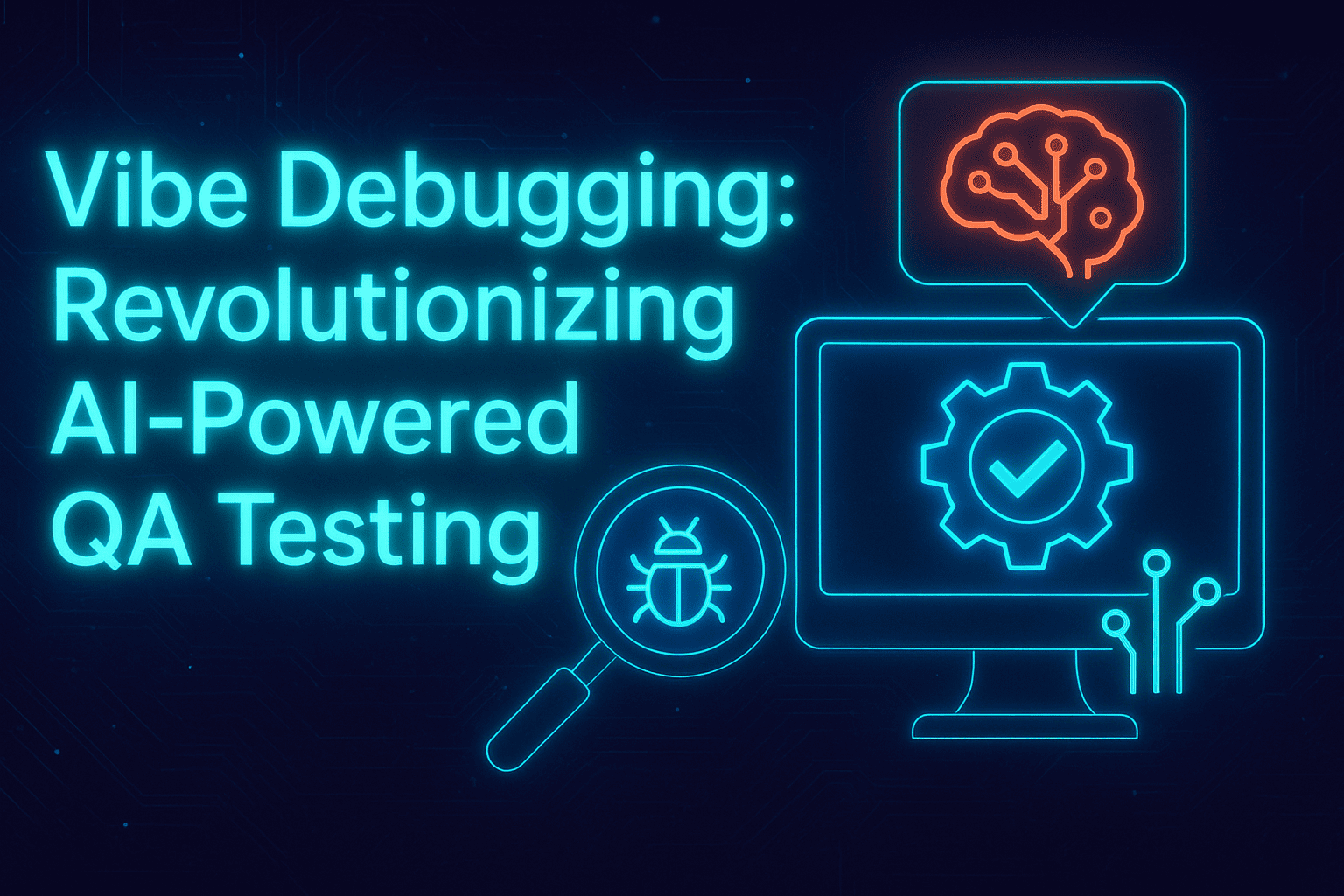The world of software development is abuzz with vibe coding – a paradigm where developers express intent in plain language and AI generates code. Yet the complementary concept of vibe debugging is just emerging. In simple terms, vibe debugging uses AI agents to diagnose and fix code issues through natural language conversations, rather than traditional breakpoints or manual inspection. This shift is especially crucial in mobile app testing. Teams today pour millions of manual hours into ensuring apps work before launch, and automated testing tools like Appium or Selenium alone struggle to keep pace. By leaning into the age of agentic AI in the QA process, we can dramatically cut debugging time and catch more bugs early.
In practice, vibe debugging means an engineer could chat with an AI assistant about a bug (“Why is this feature crashing?”), and the AI would trace through the code, reproduce the issue, and even suggest a fix in real time. This is a major leap from current workflows where developers toggle between code editors, simulators, and test reports. Today, engineers spend 30–50% of their time debugging, and the debugging phase can consume nearly 75% of development hours. Moreover, fixing a bug in production can cost up to 30× more than writing the original code. In other words, every minute saved in debugging is huge for productivity and costs. Vibe debugging aims to automate much of that work: an AI code reviewer can flag problematic functions and suggest remediation steps, while an autonomous test agent exercises the app and alerts developers to failures.
The State of QA Today: Why Change is Needed?
Despite advances in development, the QA (Quality Assurance) world still relies on the same old approaches: manual testing and rigid automation scripts. Teams write thousands of test cases and use frameworks like Selenium or Appium to automate them, but these tests often break or miss edge cases as the code evolves. Manual QA struggles to keep pace with fast-changing codebases and complex user interfaces. In fact, surveys show 40% of testers now use AI tools like ChatGPT to assist with test automation, yet 15% still report no AI usage at all. The picture is clear: QA is ripe for innovation.
Mobile testing exemplifies the challenge. Every change in code or UI can break dozens of existing tests. Teams must juggle automated mobile testing across platforms (iOS, Android) and devices, often with limited resources. No wonder nearly half of teams have already replaced at least 50% of manual testing with automation, and many view smart AI as the next frontier. AI-driven QA tools promise to reduce repetitive work, catch issues earlier, and make test coverage more targeted. For example, modern AI tools can detect flaky tests and self-heal them, or even generate new test cases from user behavior.
In practice, teams using AI-powered testing platforms report up to 70% less time spent on test maintenance and more than 50% fewer escaped UI bugs. These numbers underscore the gap that vibe debugging can fill: by combining code review and autonomous testing, AI can not only find issues but proactively fix them, saving QA engineers countless hours.
What is Vibe Debugging?
Vibe debugging is the AI-powered next step in the development cycle. Just as vibe coding lets developers focus on ideas and let AI write the code, vibe debugging lets them describe the problem and let AI identify and resolve it. In concrete terms, an AI debugging agent would understand the codebase context, simulate scenarios, and propose bug fixes in natural language. Instead of a QA engineer painstakingly setting breakpoints or writing test scripts, they could ask the agent questions like “Why does this login flow fail?” or “Fix the null-pointer error on signup,” and the AI would walk through the code logic and respond. This turns debugging into a conversation, leveraging natural language and knowledge of the entire project.
Key components of vibe debugging include:
- AI Code Review: Upon each pull request, an AI agent instantly scans the new code for defects or security issues, using static analysis and historical patterns.
- Autonomous Testing: Once code is merged, another agent runs automated tests (unit, UI, API) and even explores the app autonomously. It learns the app’s features and attempts common user flows, reporting back any unexpected behaviors.
- AI-Driven Fix Suggestions: Crucially, vibe debugging doesn’t stop at reporting bugs; it suggests fixes. An AI with code generation capability can propose code changes or additional test cases, and even apply them via commits after human review.
- Conversational Interface: All of this happens via chat or IDE plugin, keeping developers in the loop. The agent summarizes findings in plain language, and developers confirm or tweak the AI’s suggestions.
By blending these elements, vibe debugging transforms a traditionally reactive QA step into a proactive, AI-augmented process. It shifts some of the QA workload directly into the development workflow, enforcing quality and catching bugs before code reaches production.
The Role of AI in QA and Testing
The AI revolution is already touching QA in exciting ways. Industry analysts predict that by 2025, AI-driven testing will become an essential part of the development lifecycle. Teams are adopting AI QA tools to boost efficiency: these tools can generate tests from code or user logs, prioritize which tests to run based on risk, and even perform intelligent visual testing to catch UI regressions. For example, AI platforms can ingest API schemas or production error logs and automatically create relevant test cases, covering scenarios that manual engineers might miss. Developers are using ChatGPT-like models to write or debug test scripts across frameworks.
Some concrete benefits of AI in testing include:
- Flaky Test Detection: AI can spot unstable tests early, reducing time wasted on intermittent failures.
- Test Generation: From user stories or code changes, AI can craft new automated tests, accelerating coverage.
- Visual Regression Catching: Intelligent image comparison finds subtle UI bugs that basic assertions miss.
- Prioritization: By analyzing version control and historical defects, AI suggests which areas are most risky and should be tested first.
- Maintenance Reduction: Self-healing test frameworks automatically update broken test steps, cutting maintenance time dramatically.
Despite these gains, many QA processes still lack deep AI integration. Developers use traditional tools like Selenium, Playwright, and Appium, but face tedious maintenance and limited validation. Generative AI for QA is still new – only about 40% of testers currently use ChatGPT or similar for automation. That means a majority of test engineers are still manually checking features or running brittle scripts. Today, engineers spend 30–50% of their time debugging, and the debugging phase can consume nearly 75% of development hours.
Why Vibe Debugging and Not Just Vibe Coding?
You might ask: if AI can already generate code via vibe coding, why isn’t it enough to just rely on that? The reality is that writing code quickly doesn’t guarantee it’s correct or complete. Andrej Karpathy and others show vibe coding tools can quickly create MVPs, but without testing, bugs and integration issues remain. In fact, many newly-built prototypes never make it to production precisely because the QA bottleneck chokes them. Developers create thousands of apps, but only a fraction ever launch. Automated, intelligent QA fills the missing piece.
Furthermore, code generated by AI still needs oversight. Faster feature delivery doesn’t equal long-term efficiency. AI might produce code that compiles. However, without following architecture patterns or performance considerations, it could cause costly defects down the line. Modern AI-driven code review platforms mitigate these risks by enforcing secure coding guidelines and validating API integrations at review time. Vibe debugging extends this by not only checking code, but actively testing it and suggesting fixes. Vibe coding eases app creation, but vibe debugging ensures apps work reliably.
What Should a Vibe Debugging Platform Include?
A complete vibe debugging solution brings together multiple AI capabilities under one roof. Based on current trends and technical needs, a robust platform would consist of:
- AI Code Review Agent: Continuously scans code changes (PRs) with static analysis, detecting bugs, code smells, or security issues.
- Autonomous Test Runner: Launches automated tests (unit, API, UI) on every build. Even better, it can generate new tests by exploring the application intelligently – emulating user journeys, edge cases, and API calls without human-scripted tests.
- Conversational Debugger: Allows developers to query the AI in natural language. For example, “Trace the null pointer in this crash” or “Why did build #123 fail?” The AI agent walks through logs and stack traces to pinpoint root causes.
- Auto-fix Suggestions: When bugs are found, the AI proposes concrete code changes or configuration tweaks. These can be committed as Git diffs or PR comments, ready for developer review.
- IDE/CI Integrations: Tight integration with the developer’s existing tools (e.g. VSCode, GitHub, GitLab) so that all feedback appears in context.
- Human-in-the-Loop Workflow: Despite automation, humans remain essential. The platform should provide transparency (e.g. summaries of what the AI did), and allow developers to approve or reject suggested fixes.
Such a platform goes beyond current CI/CD tools by making the entire debugging process AI-driven. It’s not just running pre-written tests or auto-merging green builds; it actively finds and fixes issues across code and tests.
Building the First Vibe Debugging Platform
At Panto, we recognize this as a key missing link in modern development. That’s why we’re building the world’s first end-to-end Vibe Debugging Platform. Our vision is to unify code review, AI test automation, and conversational debugging into a single seamless workflow for development teams.
In practice, Panto’s approach will leverage multiple AI agents working in parallel. When a developer opens a pull request, Panto’s AI immediately runs code analysis and simultaneously kicks off an autonomous test suite on the change. Any failures or vulnerabilities trigger suggestions back to the developer’s IDE. Developers can then interact with the AI: for instance, asking for an explanation of a test failure or iterating on code fixes through comments.
This multi-agent pipeline lets the team focus on creativity and design, not the tedium of tracing bugs. For example, one agent can specialize in “reviewing logic correctness,” another in “security compliance,” and a third in “simulating user flows on mobile devices.” All communicate through Panto’s control layer, which coordinates actions and collates results. Importantly, humans stay in the loop – developers accept or refine the AI’s suggestions, ensuring quality and control. The result is a dramatic acceleration of the testing cycle: what used to take days of QA efforts can happen in minutes, with AI continuously learning from each fix.
Conclusion
Vibe debugging represents the next wave of QA innovation. As AI reshapes how code is written, it must also transform how software is tested and debugged. Integrating AI agents into QA reduces manual effort, catches defects early, and improves app quality. Teams using AI QA tools already see major efficiency gains, with AI testing expected to be ubiquitous by 2025.
For QA engineers and technical leaders, this is a call to action: explore AI tools today, rethink your testing pipelines, and prepare for AI-powered debugging. At Panto, we lead the charge with our vibe debugging platform, helping teams ship reliable software faster by handing debugging over to AI.






